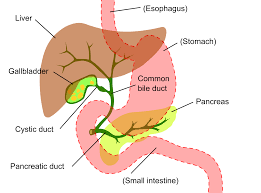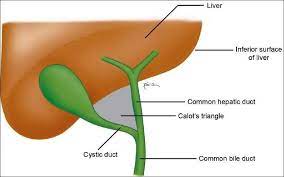
 The cystic duct is the duct that joins the gallbladder and the common hepatic duct; the union of the cystic duct and common hepatic duct forms the bile duct, formerly known as the common bile duct.
The cystic duct is the duct that joins the gallbladder and the common hepatic duct; the union of the cystic duct and common hepatic duct forms the bile duct, formerly known as the common bile duct.
It varies in length and Is often tortuous.
The cystic duct typically[2] measures 2–4 cm in length and 2–3 mm in diameter.
It is the distal continuation of the neck of the gallbladder, from where it is directed inferoposteriorly.
It typically terminates by uniting with the common hepatic duct to form the bile duct.
It often fuses with the common hepatic duct before actually opening into it after a variable distance.
The proximal cystic duct exhibits a network of submicroscopic convoluted folds (rugae), whereas that of the distal cystic duct exhibits submicroscopic parallel longitudinal folds.
The epithelial lining of the inner surface of the cystic duct is similar to that of the gallbladder and consists mostly of columnar epithelial cells with short microvilli.
The subepithelial layer consists of elastic connective tissue and is highly vascular, and are fenestrated, possibly to facilitate ion and fluid exchange with the bile.
The outer fibromuscular layer contains smooth muscle continuous with that of the gallbladder.
The cystic duct usually lies next to the cystic artery.
It may rarely be duplicated.
A pathological diverticulum (Hartmann’s pouch) may be present at the junction of the neck of bladder and the cystic duct.
The cystic duct may sometimes be extremely short, making cholecystectomy risky.
The cystic duct may be altogether absent, with the gallbladder is directly attached to the bile duct.
The shape of the cystic duct is most often tortuous, but may occasionally be curved, straight, or S-shaped.
The cystic duct may unite with the common hepatic duct so that the common hepatic duct is either very short or very long,
and the bile duct in turn very long or very short, respectively.
Very rarely, the cystic duct opens into the duodenum.
Bile can flow in either direction between the gallbladder, and the common bile duct and hepatic duct.
Bile is stored in the gallbladder in between meal times.
The hormone cholecystokinin, when stimulated by a fatty meal, promotes bile secretion by increased production of hepatic bile, contraction of the gall bladder, and relaxation of the Sphincter of Oddi.
Bile flow through the cystic duct proceeds unimpeded and is instead regulated by other mechanisms at other points of the biliary system.
Gallstones can enter and obstruct the cystic duct, preventing the flow of bile, and the increased pressure in the gallbladder leads to swelling and pain: biliary colic.
During a cholecystectomy, the cystic duct cut freeing the gallbladder to be taken out.
